U Kang
AugWard: Augmentation-Aware Representation Learning for Accurate Graph Classification
Mar 27, 2025Abstract:How can we accurately classify graphs? Graph classification is a pivotal task in data mining with applications in social network analysis, web analysis, drug discovery, molecular property prediction, etc. Graph neural networks have achieved the state-of-the-art performance in graph classification, but they consistently struggle with overfitting. To mitigate overfitting, researchers have introduced various representation learning methods utilizing graph augmentation. However, existing methods rely on simplistic use of graph augmentation, which loses augmentation-induced differences and limits the expressiveness of representations. In this paper, we propose AugWard (Augmentation-Aware Training with Graph Distance and Consistency Regularization), a novel graph representation learning framework that carefully considers the diversity introduced by graph augmentation. AugWard applies augmentation-aware training to predict the graph distance between the augmented graph and its original one, aligning the representation difference directly with graph distance at both feature and structure levels. Furthermore, AugWard employs consistency regularization to encourage the classifier to handle richer representations. Experimental results show that AugWard gives the state-of-the-art performance in supervised, semi-supervised graph classification, and transfer learning.
PULL: PU-Learning-based Accurate Link Prediction
May 20, 2024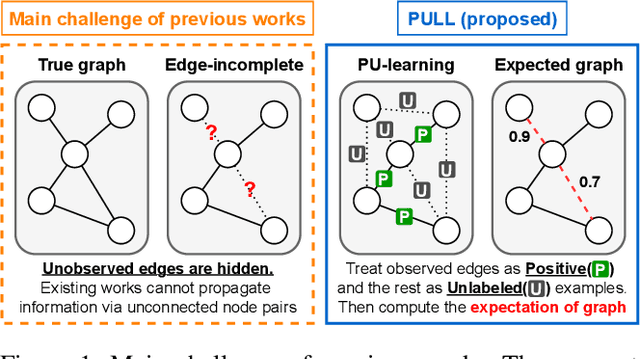



Abstract:Given an edge-incomplete graph, how can we accurately find the missing links? The link prediction in edge-incomplete graphs aims to discover the missing relations between entities when their relationships are represented as a graph. Edge-incomplete graphs are prevalent in real-world due to practical limitations, such as not checking all users when adding friends in a social network. Addressing the problem is crucial for various tasks, including recommending friends in social networks and finding references in citation networks. However, previous approaches rely heavily on the given edge-incomplete (observed) graph, making it challenging to consider the missing (unobserved) links during training. In this paper, we propose PULL (PU-Learning-based Link predictor), an accurate link prediction method based on the positive-unlabeled (PU) learning. PULL treats the observed edges in the training graph as positive examples, and the unconnected node pairs as unlabeled ones. PULL effectively prevents the link predictor from overfitting to the observed graph by proposing latent variables for every edge, and leveraging the expected graph structure with respect to the variables. Extensive experiments on five real-world datasets show that PULL consistently outperforms the baselines for predicting links in edge-incomplete graphs.
A Comprehensive Survey of Compression Algorithms for Language Models
Jan 27, 2024Abstract:How can we compress language models without sacrificing accuracy? The number of compression algorithms for language models is rapidly growing to benefit from remarkable advances of recent language models without side effects due to the gigantic size of language models, such as increased carbon emissions and expensive maintenance fees. While numerous compression algorithms have shown remarkable progress in compressing language models, it ironically becomes challenging to capture emerging trends and identify the fundamental concepts underlying them due to the excessive number of algorithms. In this paper, we survey and summarize diverse compression algorithms including pruning, quantization, knowledge distillation, low-rank approximation, parameter sharing, and efficient architecture design. We not only summarize the overall trend of diverse compression algorithms but also select representative algorithms and provide in-depth analyses of them. We discuss the value of each category of compression algorithms, and the desired properties of low-cost compression algorithms which have a significant impact due to the emergence of large language models. Finally, we introduce promising future research topics based on our survey results.
Accurate Cold-start Bundle Recommendation via Popularity-based Coalescence and Curriculum Heating
Oct 09, 2023Abstract:How can we accurately recommend cold-start bundles to users? The cold-start problem in bundle recommendation is critical in practical scenarios since new bundles are continuously created for various marketing purposes. Despite its importance, no previous studies have addressed cold-start bundle recommendation. Moreover, existing methods for cold-start item recommendation overly rely on historical information, even for unpopular bundles, failing to tackle the primary challenge of the highly skewed distribution of bundle interactions. In this work, we propose CoHeat (Popularity-based Coalescence and Curriculum Heating), an accurate approach for the cold-start bundle recommendation. CoHeat tackles the highly skewed distribution of bundle interactions by incorporating both historical and affiliation information based on the bundle's popularity when estimating the user-bundle relationship. Furthermore, CoHeat effectively learns latent representations by exploiting curriculum learning and contrastive learning. CoHeat demonstrates superior performance in cold-start bundle recommendation, achieving up to 193% higher nDCG@20 compared to the best competitor.
Fast and Accurate Transferability Measurement by Evaluating Intra-class Feature Variance
Aug 11, 2023Abstract:Given a set of pre-trained models, how can we quickly and accurately find the most useful pre-trained model for a downstream task? Transferability measurement is to quantify how transferable is a pre-trained model learned on a source task to a target task. It is used for quickly ranking pre-trained models for a given task and thus becomes a crucial step for transfer learning. Existing methods measure transferability as the discrimination ability of a source model for a target data before transfer learning, which cannot accurately estimate the fine-tuning performance. Some of them restrict the application of transferability measurement in selecting the best supervised pre-trained models that have classifiers. It is important to have a general method for measuring transferability that can be applied in a variety of situations, such as selecting the best self-supervised pre-trained models that do not have classifiers, and selecting the best transferring layer for a target task. In this work, we propose TMI (TRANSFERABILITY MEASUREMENT WITH INTRA-CLASS FEATURE VARIANCE), a fast and accurate algorithm to measure transferability. We view transferability as the generalization of a pre-trained model on a target task by measuring intra-class feature variance. Intra-class variance evaluates the adaptability of the model to a new task, which measures how transferable the model is. Compared to previous studies that estimate how discriminative the models are, intra-class variance is more accurate than those as it does not require an optimal feature extractor and classifier. Extensive experiments on real-world datasets show that TMI outperforms competitors for selecting the top-5 best models, and exhibits consistently better correlation in 13 out of 17 cases.
Knowledge-preserving Pruning for Pre-trained Language Models without Retraining
Aug 07, 2023Abstract:Given a pre-trained language model, how can we efficiently compress it without retraining? Retraining-free structured pruning algorithms are crucial in pre-trained language model compression due to their significantly reduced pruning cost and capability to prune large language models. However, existing retraining-free algorithms encounter severe accuracy degradation, as they fail to preserve the useful knowledge of pre-trained models. In this paper, we propose K-pruning (Knowledge-preserving pruning), an accurate retraining-free structured pruning algorithm for pre-trained language models. K-pruning identifies and prunes attention heads and neurons deemed to be superfluous, based on the amount of their inherent knowledge. K-pruning applies an iterative process of pruning followed by knowledge reconstruction for each sub-layer to preserve the knowledge of the pre-trained models. Consequently, K-pruning shows up to 58.02%p higher F1 score than existing retraining-free pruning algorithms under a high compression rate of 80% on the SQuAD benchmark.
Fast and Accurate Dual-Way Streaming PARAFAC2 for Irregular Tensors -- Algorithm and Application
May 28, 2023Abstract:How can we efficiently and accurately analyze an irregular tensor in a dual-way streaming setting where the sizes of two dimensions of the tensor increase over time? What types of anomalies are there in the dual-way streaming setting? An irregular tensor is a collection of matrices whose column lengths are the same while their row lengths are different. In a dual-way streaming setting, both new rows of existing matrices and new matrices arrive over time. PARAFAC2 decomposition is a crucial tool for analyzing irregular tensors. Although real-time analysis is necessary in the dual-way streaming, static PARAFAC2 decomposition methods fail to efficiently work in this setting since they perform PARAFAC2 decomposition for accumulated tensors whenever new data arrive. Existing streaming PARAFAC2 decomposition methods work in a limited setting and fail to handle new rows of matrices efficiently. In this paper, we propose Dash, an efficient and accurate PARAFAC2 decomposition method working in the dual-way streaming setting. When new data are given, Dash efficiently performs PARAFAC2 decomposition by carefully dividing the terms related to old and new data and avoiding naive computations involved with old data. Furthermore, applying a forgetting factor makes Dash follow recent movements. Extensive experiments show that Dash achieves up to 14.0x faster speed than existing PARAFAC2 decomposition methods for newly arrived data. We also provide discoveries for detecting anomalies in real-world datasets, including Subprime Mortgage Crisis and COVID-19.
Accurate Open-set Recognition for Memory Workload
Dec 17, 2022Abstract:How can we accurately identify new memory workloads while classifying known memory workloads? Verifying DRAM (Dynamic Random Access Memory) using various workloads is an important task to guarantee the quality of DRAM. A crucial component in the process is open-set recognition which aims to detect new workloads not seen in the training phase. Despite its importance, however, existing open-set recognition methods are unsatisfactory in terms of accuracy since they fail to exploit the characteristics of workload sequences. In this paper, we propose Acorn, an accurate open-set recognition method capturing the characteristics of workload sequences. Acorn extracts two types of feature vectors to capture sequential patterns and spatial locality patterns in memory access. Acorn then uses the feature vectors to accurately classify a subsequence into one of the known classes or identify it as the unknown class. Experiments show that Acorn achieves state-of-the-art accuracy, giving up to 37% points higher unknown class detection accuracy while achieving comparable known class classification accuracy than existing methods.
Accurate Action Recommendation for Smart Home via Two-Level Encoders and Commonsense Knowledge
Aug 12, 2022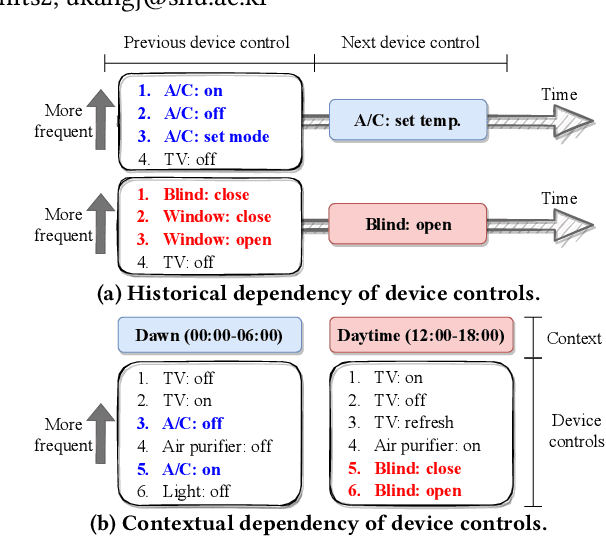
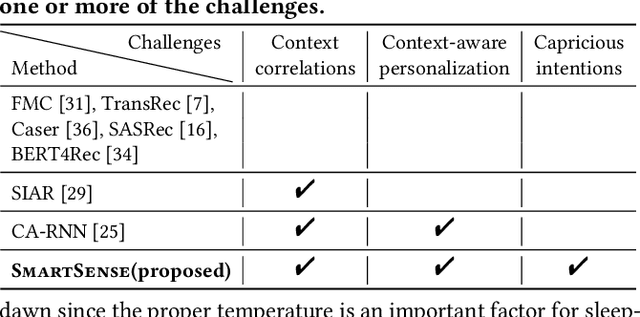
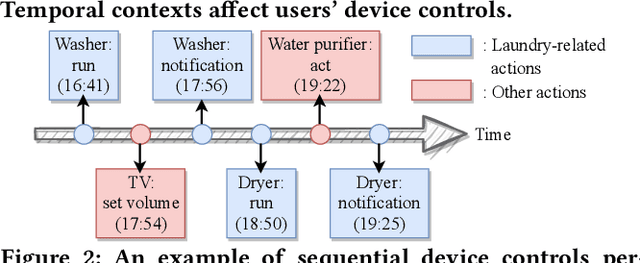
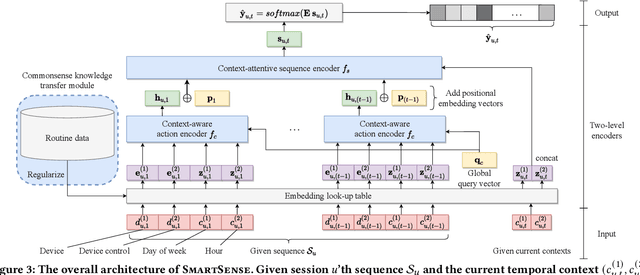
Abstract:How can we accurately recommend actions for users to control their devices at home? Action recommendation for smart home has attracted increasing attention due to its potential impact on the markets of virtual assistants and Internet of Things (IoT). However, designing an effective action recommender system for smart home is challenging because it requires handling context correlations, considering both queried contexts and previous histories of users, and dealing with capricious intentions in history. In this work, we propose SmartSense, an accurate action recommendation method for smart home. For individual action, SmartSense summarizes its device control and its temporal contexts in a self-attentive manner, to reflect the importance of the correlation between them. SmartSense then summarizes sequences of users considering queried contexts in a query-attentive manner to extract the query-related patterns from the sequential actions. SmartSense also transfers the commonsense knowledge from routine data to better handle intentions in action sequences. As a result, SmartSense addresses all three main challenges of action recommendation for smart home, and achieves the state-of-the-art performance giving up to 9.8% higher mAP@1 than the best competitor.
Accurate Node Feature Estimation with Structured Variational Graph Autoencoder
Jun 09, 2022



Abstract:Given a graph with partial observations of node features, how can we estimate the missing features accurately? Feature estimation is a crucial problem for analyzing real-world graphs whose features are commonly missing during the data collection process. Accurate estimation not only provides diverse information of nodes but also supports the inference of graph neural networks that require the full observation of node features. However, designing an effective approach for estimating high-dimensional features is challenging, since it requires an estimator to have large representation power, increasing the risk of overfitting. In this work, we propose SVGA (Structured Variational Graph Autoencoder), an accurate method for feature estimation. SVGA applies strong regularization to the distribution of latent variables by structured variational inference, which models the prior of variables as Gaussian Markov random field based on the graph structure. As a result, SVGA combines the advantages of probabilistic inference and graph neural networks, achieving state-of-the-art performance in real datasets.
 Add to Chrome
Add to Chrome Add to Firefox
Add to Firefox Add to Edge
Add to Edge